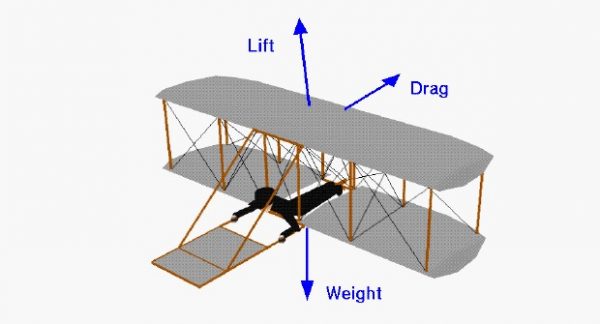Three Forces on a Glider

A force may be thought of as a push or pull in a specific direction. This slide shows the forces that act on the Wright 1900 aircraft when flown as a piloted glider. You can compare these forces to the forces on the aircraft when flown as a kite and you will note only a few differences. There are also a few differences from the forces on a powered aircraft. But the similarities are so great that the Wrights were able to learn the basics of flight control by flying their unpowered aircraft as a glider. You can also learn the basics of aerodynamics by flying a glider or paper airplane. The forces on your glider are exactly the same as the forces on the Wright brothers’ glider.
Weight
Weight is a force that is always directed toward the center of the earth. The magnitude of the force depends on the mass of all the parts of the aircraft including the pilot. The weight is distributed throughout the aircraft, but we can often think of it as collected and acting through a single point called the center of gravity. In flight, a glider rotates about the center of gravity.
Lift
To make a glider fly, we must generate a force to overcome the weight. This force is called the lift and is generated by the motion of the glider through the air. Lift is an aerodynamic force (“aero” stands for the air, and “dynamic” denotes motion). Lift is directed perpendicular (at right angle) to the flight direction. As with weight, each part of the glider contributes to a single lift force. Most of the lift of the Wright glider was generated by the wings. The lift acts through a single point called the center of pressure. The center of pressure is defined just like the center of gravity, but using the pressure distribution around the body instead of the weight distribution.
Drag
As the glider moves through the air, the air resists the motion of the glider. This resistance force is called the drag of the glider. The direction of the drag force is always opposite the direction of the motion. Drag acts through the center of pressure in the same way that lift acts through the center of pressure. (In reality, there is only one aerodynamic force on the glider. Engineers break this force into lift and drag to more easily explain the motion of the glider along its flight path.)
In order for a glider to fly, it must generate lift to oppose the weight. To generate lift, the glider must move through the air. But the motion of the glider through the air generates drag. In a powered aircraft, the thrust from the engine opposes drag. The glider, however, has no engine to generate thrust. So how does a glider generate the velocity needed for flight? The simple answer is that a glider trades altitude for velocity. It trades the potential energy difference from a higher altitude to a lower altitude to produce kinetic energy, which means velocity. Gliders always descend relative to the air in which they are flying. In the case of the Wright aircraft, the glider was flown from the top of a sand dune and was only airborne for a short time.
